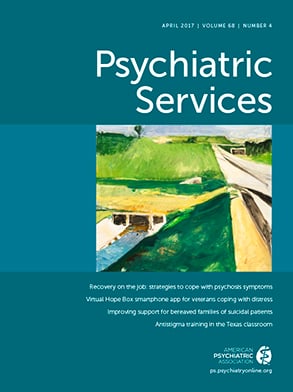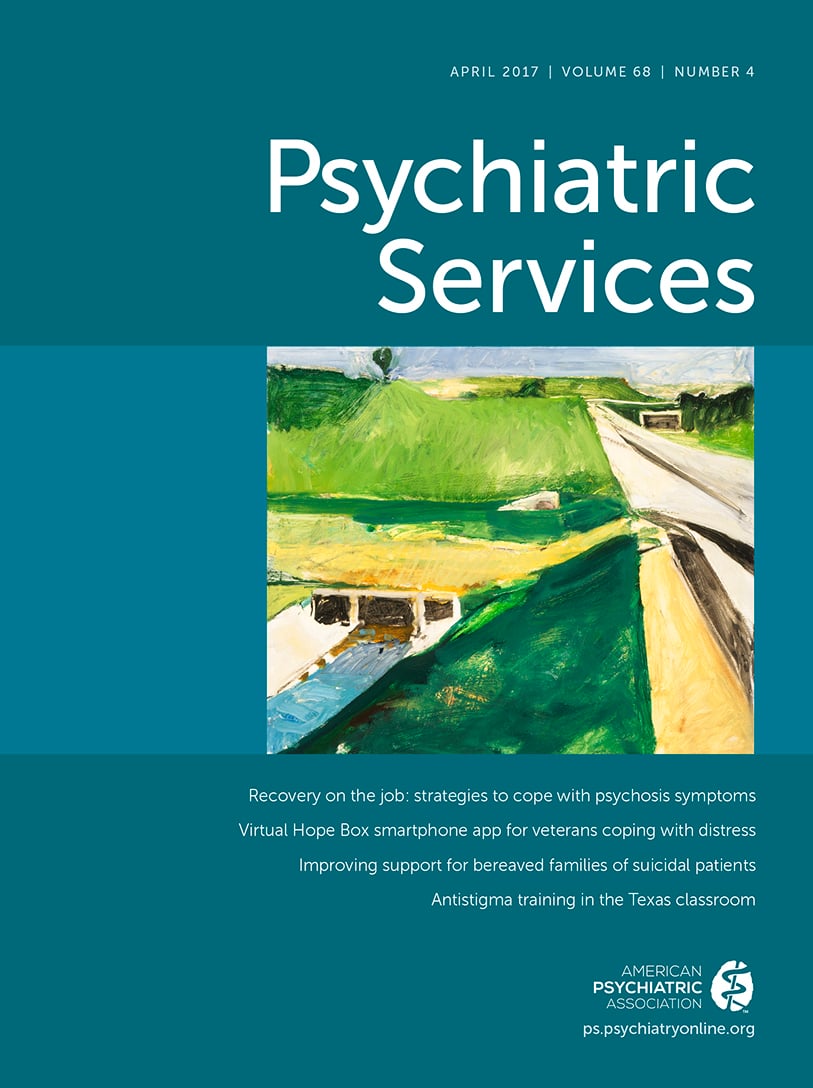About 17.5% of U.S. adults and more than 9% of the population 11 years and older have a diagnosed substance use disorder (
1). Since deinstitutionalization, the formal care sector has emphasized community care rather than hospital admission for mental and substance use disorders. However, inadequate insurance coverage, a shortage of mental health services and professionals, inefficient triage practice systems, and the high cost of mental health services (
2) channel individuals with mental and substance use disorders to hospital emergency rooms (ERs) (
3), which imposes a major strain on limited health care resources (
4). No estimates of spending on ER visits for mental and substance use disorders have been published. However, in general, almost 6% of U.S. health care dollars are spent on mental health, and the national expenditure on services for mental and substance use disorders rose 7.9% in the first quarter of 2015 compared with the same period in 2014 (
5). Although specialty mental health providers are projected to remain major recipients of spending on mental and substance use disorders, the share received by nonspecialty providers, including ER and outpatient providers, is projected to rise from 28% in 2009 to 30% in 2020 (
6).
In the 1990s and early 2000s, significant increases were noted in ER visits for mental health reasons. From 1992 to 2001, the annual number of ER visits increased by 20%; however, the per-person trend for mental health–related visits increased by nearly 40%—from 17.1 visits per 1,000 population in 1992 to 23.6 visits per 1,000 population in 2001 (
4). Researchers found that African Americans had higher visit rates than whites, that Medicaid enrollees made more ER visits than privately insured and uninsured persons, and that individuals with psychiatric conditions were more likely than those with general medical conditions to be admitted to the hospital (
7,
8).
This brief report presents a profile of visits to hospital ERs for mental and substance use disorders from 2005 to 2011. Data were from the National Hospital Ambulatory Medical Care Survey (NHAMCS) database. The focus of our study is important in the context of the unfolding of the Affordable Care Act (ACA), which mandates provision of mental health services as essential health benefits for insured persons, and the Mental Health Parity and Addiction Equity Act (MHPAEA). This study sought to establish a baseline against which future changes can be compared after the ACA and MHPAEA are fully implemented.
Methods
This study compared characteristics of ER visits for mental and substance use disorders and visits for physical health conditions. The study was a retrospective, cross-sectional analysis of NHAMCS data from 2005 to 2011. The NHAMCS is an annual survey of hospital visits conducted by the Centers for Disease Control and Prevention’s National Center for Health Statistics (CDC/NCHS) and includes data on the use and provision of ambulatory and emergency care services in nonfederal and non–Department of Veterans Affairs hospitals in all 50 states and the District of Columbia.
The outcome variable was ER visits for 2005 to 2011. Mental health visits were identified by using CDC/NCHS reason-for-visit codes, such as 1100.0 (anxiety and nervousness), 1110.0 (depression), 1155.0 (delusions or hallucination), 1145.0 (alcohol-related problems), 2321.0 (drug dependence), 5820.1 (intentional overdose), and a host of others. The independent variables in our regression model included demographic variables, such as gender, race-ethnicity, age, region of residence, residential status, and insurance coverage. We also controlled for discharge status from any hospital within the past seven days to document complications and indicate quality of inpatient care; whether the patient was seen in the past 72 hours, an indicator of the quality of care or follow-up for patients lacking a customary source of care outside the ER; and hospital ownership status to identify differences in ownership, resource capacity, demographic factors, and competitive characteristics (
9) of public facilities compared with other types of ownership. The regression model also included indicators for each calendar year.
Results
Descriptive statistics comparing ER use for mental and substance use disorders in 2005 and 2011 indicated an increasing trend—from a rate of 27.9 per 1,000 ER visits in 2005 to 35.1 per 1,000 in 2011. [A table in an online supplement to this report presents descriptive statistics.] Overall, the mean±SD age of persons with ER visits for mental and substance use disorders was 39.9±.41 years. From 2005 to 2011, the number of ER visits for mental and substance use disorders increased significantly for all age groups over six years. The increase was highest for the 25- to 44-year group—from 32.7 per 1,000 ER visits in 2005 to 42.3 per 1,000 ER visits in 2011. The increasing trend in such visits was significant and consistent over time for both males and females. The rate for males increased from 32.9 per 1,000 visits in 2005 to 38.7 per 1,000 visits in 2011, and the respective increase for females was from 23.7 to 32.2. The data also showed that homeless persons and nursing home residents had the highest rate of ER visits for mental and substance use disorders (173.7 and 95.2 per 1,000 ER visits, respectively).
Table 1 presents results of a logistic regression examining variables as predictors of ER visits for mental and substance use disorders. The overall model goodness of fit to the 193,526 data points was reasonably good, compared with an intercept-only model (likelihood ratio χ
2=3,919.82, df=24, p<.001).
Covariates in the fitted model were statistically significant, except for two: the binary indicators for being seen in an ER in the past 72 hours and ownership status of the hospital. Men were 1.27 times as likely as women to visit the ER for mental and substance use disorders. Compared with white patients, Hispanic and African-American patients were less likely to visit the ER for mental and substance use disorders. Compared with visits by individuals age 65 and older, all age groups were more likely to visit the ER for mental and substance use disorders, except for children under age 18. Compared with persons who lived in their own homes, homeless persons were 6.36 times as likely and nursing home residents were 3.16 times as likely to make such visits.
Compared with patients with private insurance, uninsured patients, Medicare enrollees, and Medicaid enrollees were, respectively, 1.30, 1.66, and 1.65 times as likely to visit the ER for mental and substance use disorders. Patients who had been discharged from a hospital within the past seven days were 1.49 times as likely as those who had not been discharged in the past seven days to make an ER visit for mental and substance use disorders. Compared with people living in the Northeast, those living in the South, Midwest, and West were less likely to visit the ER for mental or substance use disorders.
Discussion and Conclusions
Since passage of the ACA and the MHPAEA, more individuals who visit the ER for mental and substance use disorders have health insurance coverage. The aim of this study was to establish a baseline against which future changes in the ER visits for mental and substance use disorders can be compared after the ACA and MHPAEA are fully implemented.
We fit a logistic regression model to the 2005 to 2011 NHAMCS data to profile characteristics of ER visits for mental and substance use disorders. Among significant predictors of such visits in the estimated model were being homeless or being a nursing home resident (compared with living in a private residence). Our finding on homelessness is in line with a previous study of why the provision of emergency care in U.S. hospitals is costly (
10). The finding about nursing home residents agrees with results of another study, which showed that nursing home patients were routinely transferred to hospital ERs for general medical and mental health conditions, even though such hospitalizations were avoidable (
2). As noted in previous studies, low-cost and effective collaborations among hospitals, nursing homes, and community outpatient services could reduce high rates of ER use among nursing home residents. Although more U.S. females than males are reported to have a mental illness, studies have indicated that males are more likely to visit ERs for mental health problems (
3). Because of gender-specific physiology and other factors, females tend to be better seekers of health care and more frequent users of health care resources (
11); however, seeking care and having a regular source of care are influenced by several factors, including availability of services and health insurance coverage. Compared with white patients, Hispanic and African-American patients were less likely to visit the ER for mental and substance use disorders, a finding echoing the greater relative deaths from conditions related to mental health recently observed among less educated whites (
12). In this study, we found a significant correlation between insurance coverage and ER visits for mental and substance use disorders, compared with physical health conditions. Compared with patients with private insurance, uninsured patients were more likely to visit the ER for mental and substance use disorders, as were Medicare and Medicaid enrollees—although the odds were not as high as for uninsured patients. The statistically significant findings on gender are consistent with other studies which find gender differences in health services utilization (
13,
14).
The profile of ER visits for mental and substance use disorders in U.S. hospitals differed significantly from the profile of ER visits for physical health conditions. As the consequences of ACA and MHPAEA implementation become clearer, understanding the difference in these profiles can help inform the design of more cost-effective policies to guide ER intake. In addition, our findings that patients with different reasons for visiting the ER also differed in region of residence, socioeconomic status, and living arrangement can help inform policies that target the needs of specific populations. The findings could also be used to plan for and ensure that the ER team has an appropriate mix of clinical skills. Although our study fills an important void regarding an increasingly important health policy issue, future research should focus on the cost implications and outcomes of ER use for mental and substance use disorders.

